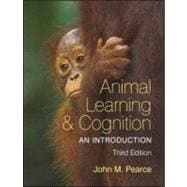
Note: Supplemental materials are not guaranteed with Rental or Used book purchases.
Purchase Benefits
Looking to rent a book? Rent Animal Learning and Cognition, 3rd edition: An Introduction [ISBN: 9781841696560] for the semester, quarter, and short term or search our site for other textbooks by Pearce; John M.. Renting a textbook can save you up to 90% from the cost of buying.
| Preface | p. ix |
| The study of animal intelligence | p. 2 |
| The distribution of intelligence | p. 4 |
| Defining animal intelligence | p. 12 |
| Why study animal intelligence? | p. 16 |
| Methods for studying animal intelligence | p. 20 |
| Historical background | p. 22 |
| Associative learning | p. 34 |
| Conditioning techniques | p. 36 |
| The nature of associative learning | p. 42 |
| Stimulus-stimulus learning | p. 49 |
| The nature of US representations | p. 52 |
| The conditioned response | p. 55 |
| Concluding comment: the reflexive nature of the conditioned response | p. 60 |
| The conditions for learning: Surprise and attention | p. 62 |
| Surprise and conditioning | p. 64 |
| Conditioning with a single CS | p. 64 |
| Conditioning with a compound CS | p. 68 |
| Evaluation of the Rescorla-Wagner model | p. 72 |
| Attention and conditioning | p. 74 |
| Wagner's theory | p. 76 |
| Stimulus significance | p. 80 |
| The Pearce-Hall theory | p. 86 |
| Concluding comments | p. 91 |
| Instrumental conditioning | p. 92 |
| The nature of instrumental learning | p. 93 |
| The conditions of learning | p. 97 |
| The performance of instrumental behavior | p. 106 |
| The Law of Effect and problem solving | p. 111 |
| Extinction | p. 122 |
| Extinction as generalization decrement | p. 123 |
| The conditions for extinction | p. 125 |
| Associative changes during extinction | p. 134 |
| Are trials important for Pavlovian extinction? | p. 142 |
| Discrimination learning | p. 148 |
| Theories of discrimination learning | p. 149 |
| Connectionist models of discrimination learning | p. 161 |
| Metacognition and discrimination learning | p. 166 |
| Category formation | p. 170 |
| Examples of categorization | p. 171 |
| Theories of categorization | p. 173 |
| Abstract categories | p. 179 |
| Relationships as categories | p. 180 |
| The representation of knowledge | p. 188 |
| Short-term retention | p. 190 |
| Methods of study | p. 191 |
| Forgetting | p. 199 |
| Theoretical interpretation | p. 202 |
| Serial position effects | p. 206 |
| Metamemory | p. 207 |
| Long-term retention | p. 212 |
| Capacity | p. 214 |
| Durability | p. 215 |
| Theoretical interpretation | p. 218 |
| Episodic memory | p. 225 |
| Time, number, and serial order | p. 232 |
| Time | p. 233 |
| Number | p. 243 |
| Serial order | p. 253 |
| Transitive inference | p. 259 |
| Concluding comments | p. 262 |
| Navigation | p. 264 |
| Short-distance travel | p. 265 |
| Methods of navigation | p. 265 |
| Long-distance travel | p. 283 |
| Navigational cues | p. 284 |
| Homing | p. 286 |
| Migration | p. 289 |
| Concluding comments | p. 293 |
| Social learning | p. 296 |
| Diet selection and foraging | p. 298 |
| Choosing a mate | p. 301 |
| Fear of predators | p. 301 |
| Copying behavior: mimicry | p. 302 |
| Copying behavior: imitation | p. 304 |
| Theory of mind | p. 312 |
| Self-recognition | p. 319 |
| Concluding comments | p. 324 |
| Animal communication and language | p. 326 |
| Animal communication | p. 327 |
| Communication and language | p. 336 |
| Can an ape create a sentence? | p. 339 |
| Language training with other species | p. 350 |
| The requirements for learning a language | p. 356 |
| The distribution of intelligence | p. 360 |
| Intelligence and brain size | p. 361 |
| The null hypothesis | p. 364 |
| Intelligence and evolution | p. 369 |
| References | p. 373 |
| Author index | p. 403 |
| Subject index | p. 411 |
| Table of Contents provided by Ingram. All Rights Reserved. |
The New copy of this book will include any supplemental materials advertised. Please check the title of the book to determine if it should include any access cards, study guides, lab manuals, CDs, etc.
The Used, Rental and eBook copies of this book are not guaranteed to include any supplemental materials. Typically, only the book itself is included. This is true even if the title states it includes any access cards, study guides, lab manuals, CDs, etc.